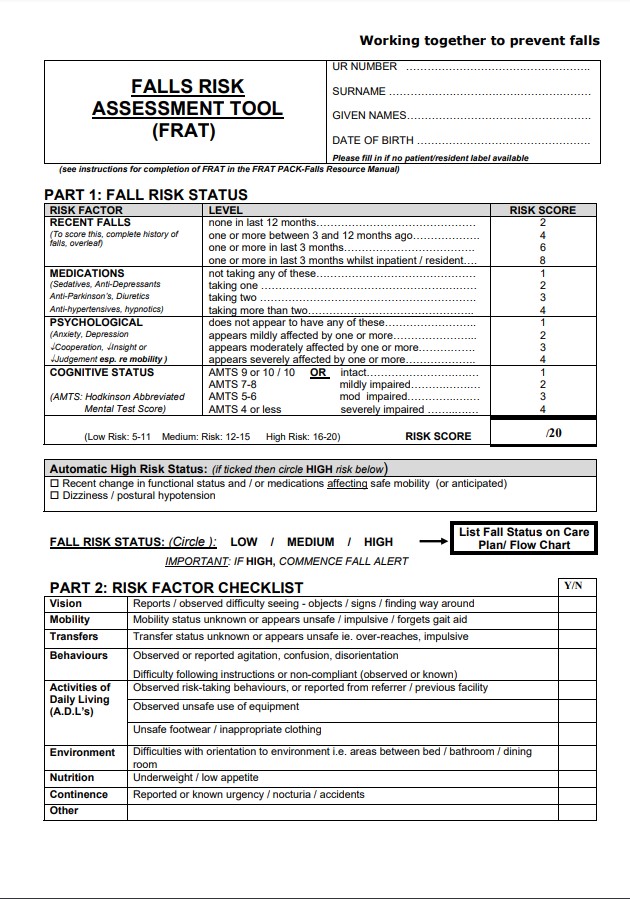The Of Dementia Fall Risk
Table of ContentsSome Known Questions About Dementia Fall Risk.The Ultimate Guide To Dementia Fall RiskThe Main Principles Of Dementia Fall Risk How Dementia Fall Risk can Save You Time, Stress, and Money.Fascination About Dementia Fall Risk
You may be worried due to the fact that you've had a fall before or due to the fact that you've discovered you're starting to really feel unsteady on your feet. You could have observed changes to your health and wellness, or just really feel like you're reducing down a little. Whatever the reason, it isn't uncommon to come to be cautious and lose confidence, and this can stop you doing the points you used to do and make you really feel more isolated.If you have actually had a loss or you've started to really feel unsteady, tell your physician even if you really feel great or else. Your physician can examine your equilibrium and the means you walk to see if enhancements can be made. They might be able to refer you for a drops danger evaluation or to the drops prevention service.
This info can be obtained via meetings with the person, their caretakers, and an evaluation of their clinical records. Begin by asking the specific regarding their history of falls, including the frequency and situations of any kind of current drops. Dementia Fall Risk. Inquire regarding any kind of mobility problems they might experience, such as unstable or difficulty walking
Conduct an extensive evaluation of the individual's medicines, paying certain focus to those known to increase the danger of falls, such as sedatives or medicines that lower blood pressure. Establish if they are taking several medicines or if there have been current adjustments in their medicine routine. Review the person's home environment for potential threats that might enhance the danger of falls, such as bad illumination, loosened rugs, or lack of grab bars in the restroom.
A Biased View of Dementia Fall Risk
Overview the person with the autumn threat assessment kind, clarifying each question and taping their actions accurately. Make certain that the individual understands the objective of the analysis and feels comfy giving honest solutions. Calculate the complete risk score based on the feedbacks offered in the analysis form. Establish the individual's threat category (low, tool, or high) based upon the total score and the existence of automated risky status aspects.
Frequently monitor the individual's progression and reassess their risk of drops as needed. Provide ongoing education and learning and assistance to advertise safety and security and reduce the risk of falls in their daily living activities.
Many studies have actually revealed that physical treatment can assist to lower the risk of dropping in grownups ages 65 and older. In a new research (that considered drops risk in women ages 80 and older), researchers determined the financial impact of choosing physical treatment imp source to prevent drops, and they discovered that doing so saves $2,144, including all the concealed costs of your time, discomfort, missed life occasions, and the bucks paid for solutions.
3 Easy Facts About Dementia Fall Risk Described
Examining your heart rate and blood stress dimensions at rest and while you alter positions (from resting or lying to standing). A straightforward examination of your reasoning (cognitive) capabilities. Examining your balance, stamina, and strolling ability. A basic vision examination. Evaluating your feet and footwear. A home safety and security assessment. Based on the examination results, your physical therapist will make a plan that is tailored to your certain demands.
Older adults who have difficulty walking and talking at the same time are at a higher danger of dropping. Dementia Fall Risk. To aid enhance your safety during day-to-day tasks, your physical therapist might design a training program that will certainly challenge you to preserve standing and strolling while you do visit this page an additional job. Examples include walking or standing while counting backward, having a discussion, or lugging a bag of grocery stores
Establish goals for increasing their physical task. Exercise more to increase their toughness and balance. These programs typically are led by volunteer trainers.
Top Guidelines Of Dementia Fall Risk

Measles, or rubeola, is a very transmittable, severe viral infectious disease created by the measles virus. Some people consider measles as simply a rash and fever that clears up in a couple of days; nevertheless, measles can cause serious health and wellness issues, particularly in kids younger than 5-years-old. The most effective defense versus measles is the measles, mumps, and rubella (MMR) injection.
Loss are a i was reading this common reason of injury amongst older grownups.
The Single Strategy To Use For Dementia Fall Risk
-copy-5.jpg)
She has a case history of seizure disorder and hypertension. She is obtaining an IV mixture and taking Gabapentin and Lasix. She has no background of falls, her stride is constant, and she voids without issues. The previous nurse states that she requires aid to the restroom when she needs to go.
Examples of typical loss interventions/measures consist of: Making sure an individual's necessary things are within reach. Past comprehending just how to utilize the Johns Hopkins Fall Threat Evaluation Tool, it's essential that facilities include its usage right into an extra comprehensive fall prevention strategy.